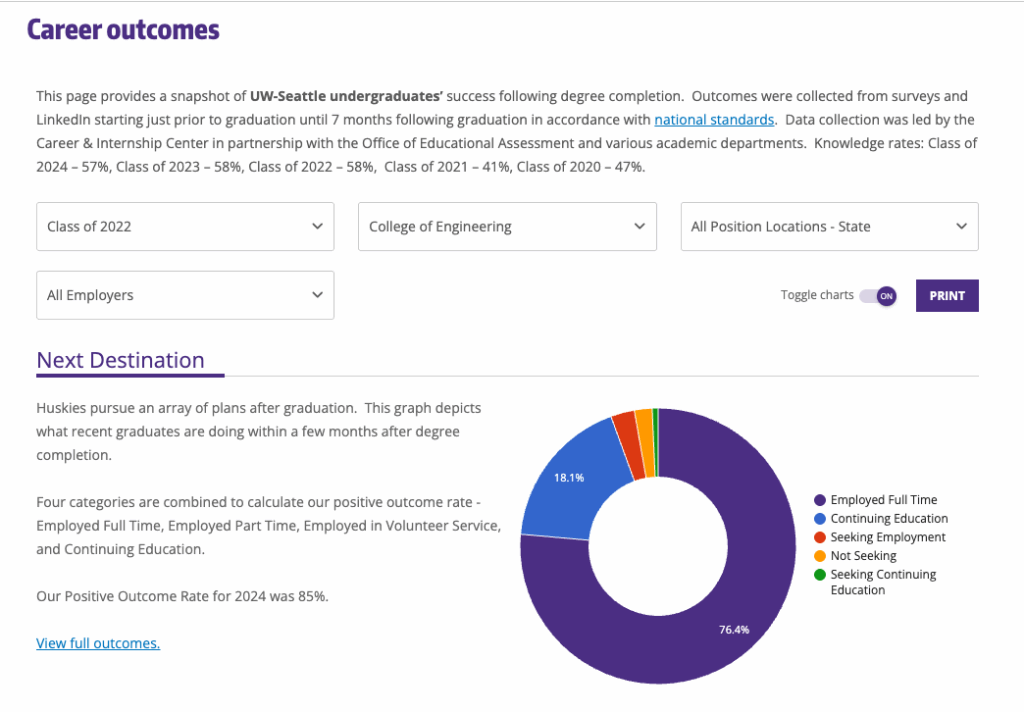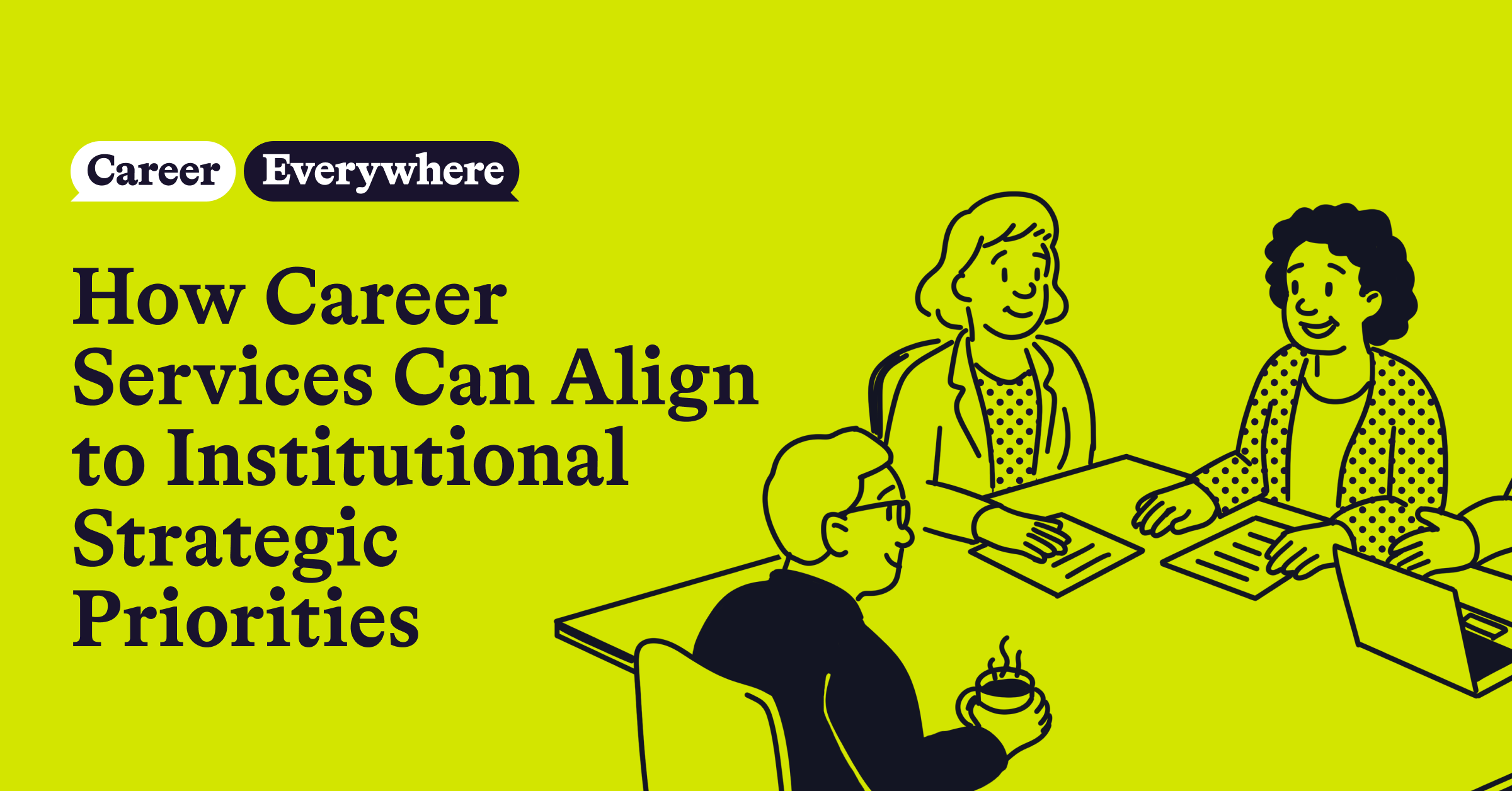
When it comes to proving the impact of career services, many career leaders feel stuck reporting the basics, like appointment counts, event attendance, or the percentage of students employed within six months.
While those numbers certainly matter, they don’t tell the whole story.

As longtime career services leader and now consultant Rebekah Paré explained on the Career Everywhere Podcast, effectiveness has to be defined through the eyes of your stakeholders.
“When we talk about effectiveness, the first question I always ask is: Effective according to whom? Different stakeholders—students, faculty, presidents, employers, alumni—define our success differently. If you serve them all the same way, you’re going to inevitably miss the mark,” Paré said.
So how can career leaders move beyond surface-level metrics? Paré outlined five key elements of effectiveness that every career center should evaluate and, just as importantly, communicate.
1. Strategic orientation: Are you leading or reacting?
Too often, career centers operate with a well-meaning list of initiatives that don’t always directly tie into what the institution values most, like enrollment or retention. In other words, the revenue drivers.
Paré advised career leaders to ask themselves: “Do you have defined goals and key progress indicators? Who helped shape those goals? Are they aligned with institutional strategic priorities?”
This means engaging deans, faculty, and senior leaders in setting your career center’s goals, not just your own team. By doing so, you position your office as a driver of institutional strategy rather than a peripheral student service.
And when career services leaders take the initiative to tie their work to institutional strategies, and proactively communicate that to senior leaders, they become known as true leaders and partners on campus. Ones that definitely should be at the table during strategic planning discussions.
Quick checklist:
- Define goals and KPIs that connect to student success, retention, or workforce readiness
- Involve deans, faculty, and students in shaping those goals.
- Audit your initiatives: Which ones tie directly to institutional strategy? Which don’t?
- Eliminate or reframe initiatives that don’t clearly support strategic priorities.
- Regularly revisit and adjust goals as institutional priorities shift.
2. Institutional alignment: Do you support campus priorities?
Similarly, Paré urged career leaders to “look up” more often. It can be easy to get bogged down in the day-to-day requirements of the career center, but it’s also important for career leaders to zoom out and take stock of what other departments are doing or what senior leaders are talking about.
“How are you helping your institution achieve its own goals? Does your plan map to the university’s strategic goals? Are you seen as essential to conversations about enrollment, belonging, or workforce impact?” Paré asked.
For example, if your institution has a new strategic plan, find out who’s shaping it and share concise summaries of how career services can contribute.
Or if your president is giving a state of the university address, make sure to attend and take note of what themes or topics are important to the president. Then send a follow-up to the president (and/or other senior leaders) outlining how the career center plans to support.
As Paré noted: “You don’t want to be in the position of running to catch up. The most effective centers are partners in delivering on the university’s core promises to students.”
Quick checklist:
- Study your institution’s strategic plan, accreditation reports, and president’s speeches (you could even use AI to help pull out common themes and trends).
- Meet regularly with campus influencers and senior leaders to learn their priorities.
- Share what you’re hearing with your team and reflect those themes in your career center’s goals.
- Create one-page briefs that connect career initiatives to institutional outcomes.
- Position career services as essential in issues like enrollment, retention, and workforce readiness.
3. Academic integration: Are you bridging academics and career?
Academic integration goes far beyond the occasional classroom visit.
As Paré put it, “When I say collaborating, I don’t mean going in and doing a five-minute spiel about, ‘Hey, this is what we do at the career center.’ I mean how are you working with your faculty on course development so they can integrate the NACE competencies or project-based learning?”
The goal is to bridge the gap between academics and career outcomes. Many students don’t automatically see that connection, and some don’t even realize they’re gaining transferable skills.
“I’ve had students tell my team they didn’t learn any skills over their four years of college, and that breaks my heart. Nobody told them they learned skills, so they just didn’t think about it,” Paré said.
By embedding career competencies into assignments, projects, and discussions, career centers can help students articulate those skills long before graduation. And the impact is broader (and more equitable) than just the students who already opt in to career services.
Paré also encouraged career leaders to think across disciplines. Pre-professional programs may be the most intuitive to partner with, but arts, humanities, and even math and sciences departments are often more open to collaboration—especially as they grapple with questions of enrollment and relevance.
Finally, the most powerful outcomes come when faculty themselves become career advocates.
“They’re the ones who are going to stand up at meetings, raise their hand, and tell all their peers about why this matters,” Paré said.
Quick checklist:
- Identify faculty champions: Start with your strongest partners or those most open to collaboration (often in arts, humanities, or departments with enrollment concerns).
- Build relationships with deans: Ask what their goals are and where career competencies might fit.
- Co-design curriculum: Work with faculty to embed NACE competencies, project-based learning, or experiential elements into courses. (Check out this episode of the Career Everywhere Podcast for a great example)
- Pilot small projects: Test integration in one class or department before expanding.
- Amplify faculty advocates: Encourage supportive faculty to share successes with their peers and at department meetings. Be their biggest cheerleader.
Aside from embedding career into classes directly, career services can also work with Academic Affairs and/or Admissions to embed career outcomes data on program webpages. That way, current and prospective students can see what past alumni in each program went on to do in their careers (and where they live, what their salaries are, what job titles they have, whether they completed an internship or not, and more).
Career leaders who use uConnect’s Outcomes Data Visualization module can embed outcomes data on their own website or virtual career center and on program pages—at no extra cost and with minimal technical lift. Plus, the module allows career leaders to refine the data based on what program page it lives on.
For example, the University of Washington’s career center worked with Admissions to embed outcomes data (via uConnect’s ODV module) on all major pages on the admissions website, including Electrical and Computer Engineering, History, and Microbiology.

For tips on how to embed career into curriculum, check out the Career Everywhere Podcast (particularly this episode with Michigan State and this episode with the University of Oregon).
4. Student reach and service design: Who are you reaching? Who’s still missing?
Effectiveness isn’t just about how many students you serve. It’s also about who you’re reaching and who you’re not.
“Are you disaggregating your engagement and outcomes data by major, identity, and year?” Paré asked.
That kind of detailed analysis reveals whether certain groups are being left behind. For example, Paré noted that, “Any identity group coupled with first-generation status will show an automatic drop of 10 to 15 percentage points in career outcomes.”
If career centers can intentionally address those gaps, she said, “It’s going to support all students.”
Scaling beyond one-on-ones
Traditional one-on-one advising is still valuable, but it’s not always scalable for today’s diverse student populations. Many campuses have thousands (or even tens of thousands) of students and only a handful of career staff.
“I talked to a career services leader at a community college recently. She has between 11,000 and 14,000 students a semester, and she’s a one-person operation. The first thing I said to her is, ‘You cannot do one-on-ones,’” Paré recalled.
Instead, she encouraged leaders to build a layered one-to-many service model that blends:
- Workshops
- Self-service skill-building courses (like the ones offered in uConnect’s Classes Module)
- Virtual job simulations (like those offered through Forage)
- Peer advising
- Chatbots and other scalable tools
This approach ensures students can engage at the right level, at the right time. Whether they’re traditional undergraduates or non-traditional learners balancing work and family.
Using technology to expand access
This is where technology can also play a transformative role. With platforms like uConnect’s virtual career center, leaders can:
- Track which resources students engage with most (articles, videos, labor market data, skill-building courses, virtual job simulations, AI-powered resume tools, job and internship postings, etc.)
- Ensure resources are available anytime, anywhere—not just during office hours
- Free staff time from repetitive tasks so they can focus on specialized, high-touch advising
- Improve engagement with existing tools, like Handshake, Symplicity, 12twenty, Big Interview, LinkedIn Learning, VMock, and more
Paré praised tools like uConnect’s Video Module and Classes Module, which allow students to explore industries or learn key skills in small, flexible bursts. Without requiring one-on-one time with career staff.
Keeping equity at the center
Ultimately, student reach is about equity as much as scale. Non-traditional, first-generation, and limited-income students often face the steepest barriers to career success. By diversifying service delivery, analyzing engagement patterns, and leveraging technology, career centers can ensure every student—not just the ones who already know how to find you—gets the support they need.
Quick checklist:
- Disaggregate engagement and outcomes data by major, year, and identity.
- Scaffold services across the student lifecycle (from onboarding to graduation and beyond).
- Diversify delivery methods: one-on-one, workshops, self-service resources and classes, peer advising, etc.
- Provide 24/7 access to resources through a virtual career center (like the one powered by uConnect).
- Reserve one-on-ones for specialized, high-touch support (not routine resume reviews).
5. Communications and influence: Is your impact visible?
Even the strongest career center initiative won’t get far if others can’t see or articulate your value. As Paré said, “If your impact is invisible, it doesn’t matter how good it is.”
That means communication needs to be a central part of your center’s strategy, and a key responsibility for career services leadership. And like with any good marketing strategy, you must tailor your message for your audience.
Tailoring to individual leaders
Paré shared that one of the best ways she influenced a dean when she was a career leader was by simply writing things down.
“He didn’t care how long it was. I put my ideas in writing and sent that to him in advance of our meetings. He processed that, had a lot to say, and then I could start to influence how he talked about the work,” Paré said.
For her chancellor, the strategy was different. In that case, she built a relationship with the chancellor’s speechwriter and always pared her top-line metrics down to two key bullet points.
“We’re going to be hyper focused with this group, because otherwise things can get lost,” Paré said.
The lesson? Know your leaders’ preferences. Some want detail. Some want stories. Some want two bullet points. And sometimes the best route isn’t going directly to them, but through other influencers who have their ear.
Equipping supervisors to be advocates
Your own supervisor may or may not be steeped in the career space, but they can still be a powerful ambassador if you equip them well.
When Paré was a career services leader, she always paid attention to who her supervisor was going to be meeting with in the next few weeks. And two days before a meeting, she would send her supervisor relevant talking points related to career services.
Her notes would say something like: “Hey, I know you’re meeting with Dean so-and-so. Here are five things you should know before you walk into that meeting so you’re not caught off guard.”
The result? Supervisors looked informed and appreciated the proactive support.
Creating a central source of truth
It’s also important to train people where to go for reliable, up-to-date information about career services.
“Instead of always having to send things out, you say, ‘That’s a great question. Over here is where you’ll find what you need,’” Paré said.
Platforms like uConnect’s virtual career center make this possible, since career leaders can curate resources by audience (students, faculty, employers, alumni) and keep them fresh. Plus, they can back it up with data.
For example, if your leader asks how much engagement your first-generation community page gets each month, you can tell them. If they want to know what career topics are most interesting to students right now, you can tell them.
Or if senior leadership wants proof that the tools and resources you’re paying for are actually getting used, you can report on that, too. All of that information resides in the backend of the uConnect virtual career center platform.
Quick checklist:
- Know your audience. Identify what each leader prefers (detailed reports, bullet points, stories, or data).
- Write it down. Send vision documents, briefs, or pre-meeting notes to help leaders process information in advance.
- Leverage other influencers. Build relationships with executive assistants, speechwriters, or other behind-the-scenes advocates.
- Equip your supervisor. Provide timely talking points before their key meetings so they can advocate effectively on your behalf.
- Centralize information. Use your website or virtual career center as the “source of truth” for resources, stories, and outcomes.
- Use data to reinforce impact. Pull engagement analytics to answer tough questions with confidence.
Conclusion
Measuring effectiveness requires more than tracking participation. It requires aligning with institutional goals, embedding in academics, scaling to reach all students, and communicating impact relentlessly.
As Paré put it, “When the center is truly strategic, it’s not just doing career programming. It’s really serving as a driver of institutional goals.”
For career leaders ready to prove their value, the opportunity is clear: go beyond the obvious metrics, and make your impact impossible to ignore.
To learn more from Paré, check out her episode of the Career Everywhere Podcast.

